Free fall is the motion of a body under the influence of gravity alone.
A body falling in the air, in addition to gravity, is affected by the force of air resistance, therefore, such a movement is not a free fall. Free fall is the fall of bodies in a vacuum.
The acceleration imparted to the body by gravity is called acceleration free fall . It shows how much the speed of a freely falling body changes per unit time.
Free fall acceleration is directed vertically downwards.
Galileo Galilei installed ( Galileo's law): all bodies fall to the surface of the Earth under the influence of gravity in the absence of resistance forces with the same acceleration, i.e. free fall acceleration does not depend on the mass of the body.
You can verify this using a Newton tube or a stroboscopic method.
Newton's tube is a glass tube about 1 m long, one end of which is sealed and the other is equipped with a tap (Fig. 25).
Fig.25
Let's put three different subject, such as shotgun, cork and bird feather. Then quickly turn the tube over. All three bodies will fall to the bottom of the tube, but in different time: first a pellet, then a cork, and finally a feather. But this is how bodies fall when there is air in the tube (Fig. 25, a). One has only to pump out the air with a pump and turn the tube over again, we will see that all three bodies will fall simultaneously (Fig. 25, b).
AT earthly conditions g depends on geographical latitude terrain.
Highest value it has at the pole g=9.81 m/s 2 , the smallest - at the equator g=9.75 m/s 2 . Reasons for this:
1) diurnal rotation Earth around its axis;
2) deviation of the shape of the Earth from spherical;
3) non-uniform distribution of the density of terrestrial rocks.
The free fall acceleration depends on the height h of the body above the surface of the planet. It, if we neglect the rotation of the planet, can be calculated by the formula:
where G is the gravitational constant, M is the mass of the planet, R is the radius of the planet.
As follows from the last formula, with an increase in the height of the body's rise above the surface of the planet, the acceleration of free fall decreases. If we neglect the rotation of the planet, then on the surface of the planet with a radius R
To describe it, you can use the formulas of uniformly accelerated motion:
speed equation:
kinematic equation, describing the free fall of bodies: ,
or in projection onto the axis.
Movement of a body thrown vertically
A freely falling body can move in a straight line or along curvilinear trajectory. It depends on the initial conditions. Let's consider this in more detail.
Free fall without initial velocity ( =0) (Fig. 26).
With the chosen coordinate system, the movement of the body is described by the equations: .
From the last formula, you can find the time the body falls from a height h:
Substituting the found time into the formula for velocity, we obtain the modulus of the body's velocity at the moment of fall: .
The motion of a body thrown vertically upwards initial speed (Fig. 27)

Fig.26 Fig.27
The motion of the body is described by the equations:
From the velocity equation, it can be seen that the body moves uniformly up, reaches its maximum height, and then moves down with uniform acceleration. Considering that at y=hmax the speed and at the moment when the body reaches the initial position y=0, we can find:
The time of lifting the body to the maximum height;
Maximum lifting height of the body;
Time of flight of the body;
The projection of the speed at the moment the body reaches its initial position.
Movement of a body thrown horizontally
If the velocity is not directed vertically, then the motion of the body will be curvilinear.
Consider the motion of a body thrown horizontally from a height h with a speed (Fig. 28). Air resistance will be neglected. To describe the movement, it is necessary to choose two coordinate axes - Ox and Oy. Origin of coordinates is compatible with initial position body. It can be seen from Fig. 28 that , , , .
Fig.28
Then the motion of the body will be described by the equations:
The analysis of these formulas shows that in the horizontal direction the speed of the body remains unchanged, i.e. the body moves uniformly. In the vertical direction, the body moves uniformly with acceleration g, i.e. just like a free-falling body with no initial velocity. Let's find the trajectory equation. To do this, from equation (3) we find the time
And, substituting its value into formula (4), we get:
This is the equation of a parabola. Therefore, a body thrown horizontally moves along a parabola. The speed of the body at any moment of time is directed tangentially to the parabola (see Fig. 28). The modulus of speed can be calculated using the Pythagorean theorem:
Knowing the height h from which the body is thrown, we can find the time t1 after which the body will fall to the ground. At this moment, the y-coordinate is equal to the height y 1 =h. From equation (4) we find:
Formula (5) determines the flight time of the body. During this time, the body will cover a distance in the horizontal direction l, which is called the flight range and which can be found on the basis of formula (3), given that l=x 1 . Therefore, - the range of the body. The modulus of the body's velocity at this moment .
Slowly falling bodies (MPT) bodies are called, which, after separation from the aircraft, quickly lose their translational speed and decrease with a certain equilibrium speed. These include skydivers and parachuted cargo. To characterize the ballistic properties of the MPT, the concept of equilibrium velocity at a constant air density is used.
Equilibrium rate of decline called the vertical speed of fall, at which the force of gravity is balanced by the force of air drag: G \u003d R,
where G is the force of gravity;
R is the force of air drag. Expressing in the air resistance formula R through G:
and solving this relation with respect to the rate of decline V cn, we obtain the formula for calculating the equilibrium rate: 
For a person falling in a horizontal position, the equilibrium speed occurs 10-12 s after separation from the aircraft. In the surface layer, it is equal to 50 m/s.
The use of a parachute (S = 70 - 80m 2) allows you to reduce the equilibrium speed to 4-6 m / s, which ensures a safe landing of a person (load). To reduce the time to reduce the MPT during landing from high altitudes, and also to give it a normal position by the time the main canopy opens, a stabilizing parachute is used. Having a small dome area (about 1.5 m 2), the stabilizing parachute allows the MPT to descend at a speed of 35-40 m/s until the main dome (dome system) opens.
Elements of the trajectory of the decrease in MPT.
The decrease in MPT consists of three main stages:
1. Free fall.
2. Descent on a stabilizing parachute.
3. Descent on the main parachute canopy (dome system).
When using multi-dome parachute systems, an intermediate stage arises - the stage of drawing and filling the main domes.
In the case when a stabilizing parachute is not used, two stages remain: free fall and descent on the main parachute canopy.
The trajectory of MPT reduction at each stage is characterized by the following main elements:
- loss of altitude this stage h;
- decrease time at this stage t.
The stage of free fall, in addition, is characterized by the calm relation A 0 .
Descent trajectory elements
MPT with no wind.
Free fall (from the moment of separation from the aircraft until the moment of opening of the stabilizing parachute) is characterized by a sharp decrease in the horizontal component of the MPT velocity and an increase in its vertical component. With a long free fall of the MPT, the horizontal component of its velocity vanishes, and the vertical component reaches the value of the equilibrium velocity. The descent trajectory is a ballistic curve with small radii of curvature. With a short free fall time (up to 5 s), the height loss h sv is calculated with sufficient accuracy by the formula:
With a significant fall time (jumping with a parachute opening delay), the height loss is set, and the delay time (free fall) is calculated according to special tables. The distance traveled by a parachutist during a free fall horizontal plane, is called a calm relation (relation along the course) and is denoted by A 0 . The amount of windage depends on the speed of the aircraft and the time of free fall. When calculating for landing, the value of A 0 is selected from the tables.
Descent with a stabilizing parachute in the absence of wind occurs vertically. The elements of the trajectory are interconnected by dependence : h stub = V stub. t stub
where h stub is the loss of height when descending on a stabilizing parachute;
t stub - time of decline;
V stub - the rate of descent on a stabilizing parachute.
Extraction and filling of domes of the multi-dome system begins from the moment the lock of the stabilizing parachute is activated, which unlocks the backpacks of the main canopies, and ends with the full filling of the main canopies. The filling time t nap and the loss of height h na are selected from the tables.
Lowering on the main dome (dome system). The descent time on the main domes is determined by the formula:

 where H des is the true landing height;
where H des is the true landing height;
Vocн - speed of descent on the main parachute (system).
When calculating, it is assumed: for a parachutist Vosn =5 m/s, for regular loads Vosn =10 m/s; when dropping large loads, the rate of descent is taken from the relevant forms and instructions. Total time reduction is calculated by the formula:
t obsh, \u003d t sv + t stub + t nap + t main.
AT real conditions landing, from the moment of separation from the aircraft until the moment of landing, the wind affects the MPT, which changes with altitude in direction and speed. Under the influence of wind, the MPT acquires an additional horizontal movement, called drift. The descent trajectory in this case will be a complex spatial curve. The path traveled by the MPT in the horizon plane can be represented as geometric sum calm attitude and a straight line connecting the projection of the end of the attitude A 0 with the landing point of the MPT. This segment will be the demolition of the parachutist Z under the action of the wind during the decrease in t total. In the practice of landing, not only the total drift Z, but also the drift by stages of descent (Z l , Z stub, Z nap, Z osn) can be considered. To simplify the accounting for drift, the concept of mean wind is introduced. Middle wind called fictitious wind constant speed and direction, which has the same net effect on the MHT as the actual wind that changes with height.
The value of the drift of the MHT is determined as the product of the average wind speed and the time of its decline: Z 1 = Uav. sv t sv; Z stub \u003d Uav stub t stub; Z nap \u003d Uav nap t nap; Z main \u003d Uav main t main.
When landing from heights of 800-1500m, only the total demolition of the paratrooper can be taken into account. Then: Z = Uav t total
The drift direction is determined by the direction of the average wind in a given layer of the atmosphere.
LESSON #2
Free fall is the movement of objects vertically downwards or vertically upwards. This is a uniformly accelerated movement, but a special kind of it. All formulas and laws of uniformly accelerated motion are valid for this motion.
If the body flies vertically downwards, then it accelerates, in this case the velocity vector (directed vertically downwards) coincides with the acceleration vector. If the body flies vertically upwards, then it slows down, in this case the velocity vector (directed upwards) does not coincide with the direction of acceleration. The acceleration vector in free fall is always directed vertically downwards.
Acceleration in the free fall of bodies is a constant value.
This means that no matter what body is flying up or down, its speed will change the same way. BUT with one caveat, if the force of air resistance can be neglected.
Free fall acceleration is usually denoted by a letter different from acceleration. But gravitational acceleration and acceleration are the same physical quantity and they have the same physical meaning. They participate equally in the formulas for uniformly accelerated motion.
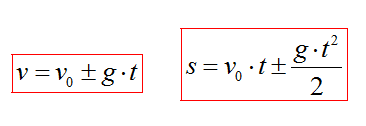
We write the "+" sign in the formulas when the body flies down (accelerates), the "-" sign - when the body flies up (slows down)
Everyone knows from school textbooks physics that in a vacuum a pebble and a feather fly the same way. But few people understand why, in a vacuum, bodies of different masses land at the same time. Like it or not, whether they are in a vacuum or in air, their mass is different. The answer is simple. The force that causes bodies to fall (gravity) is caused by gravitational field The lands of these bodies are different. It is larger for a stone (since a stone has more weight), it is smaller in a feather. But there is no dependence here: what more power, the greater the acceleration! Let's compare, we act with the same force on a heavy cabinet and a light bedside table. Under the influence of this force, the nightstand will move faster. And in order for the cabinet and bedside table to move in the same way, it is necessary to act on the cabinet more strongly than on the bedside table. The Earth does the same. It attracts heavier bodies with more force than light ones. And these forces are so distributed among the masses that as a result they all fall in a vacuum at the same time, regardless of the mass.

Separately, consider the issue of emerging air resistance. Take two identical sheets of paper. We crumple one of them and at the same time release it from our hands. The crumpled leaf will fall to the ground earlier. Here, the different fall times are not related to body mass and gravity, but are due to air resistance.

Consider a body falling from a certain height h no initial speed. If a coordinate axis To direct the OS upwards, aligning the origin of coordinates with the Earth's surface, we will obtain the main characteristics of this movement.
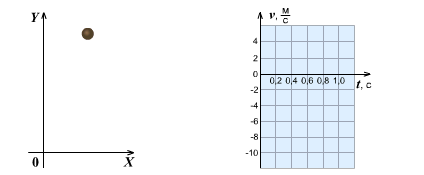
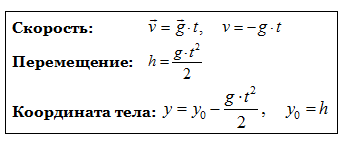
A body thrown vertically upwards moves uniformly with the acceleration of free fall. In this case, the velocity and acceleration vectors are directed to opposite sides, and the modulus of velocity decreases with time.
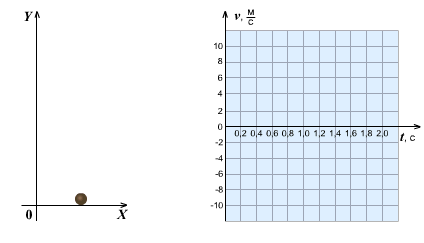
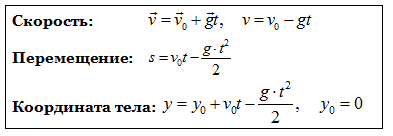
IMPORTANT! Since the rise of the body to its maximum height and the subsequent fall to the ground level are absolutely symmetrical movements (with the same acceleration, just one slowed down and the other accelerated), the speed with which the body lands will be equal to the speed with which it tossed up. In this case, the time for the body to rise to the maximum height will be equal to the time for the body to fall from this height to the ground level. Thus, the entire flight time will be double the time of ascent or fall. The speed of the body at the same level during the ascent and during the fall will also be the same.
The main thing to remember
1) The direction of acceleration in the free fall of the body;
2) Numerical value free fall acceleration;
3) Formulas
Derive a formula for determining the time of a body falling from a certain height h no initial speed.
Derive a formula for determining the time it takes a body to rise to its maximum height, thrown with an initial speed v0
Derive a formula for determining the maximum height of a body thrown vertically upwards with an initial velocity v0
